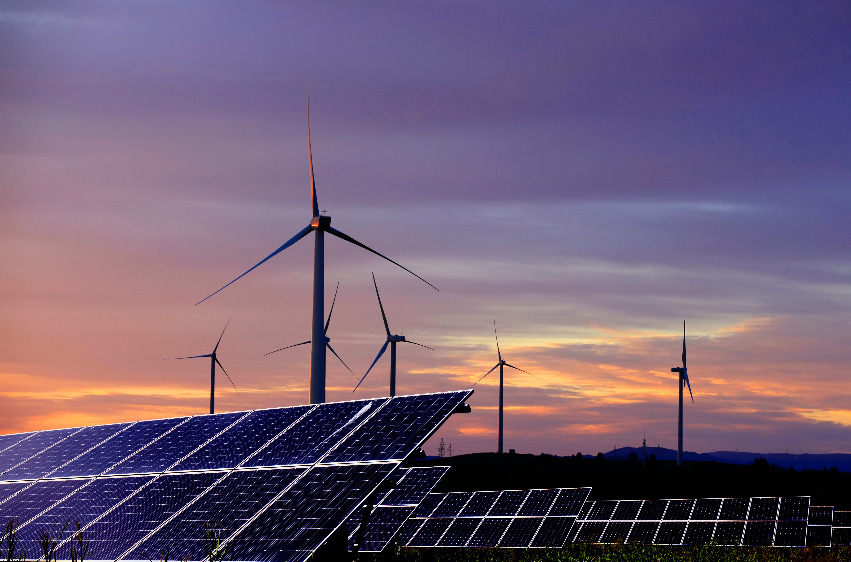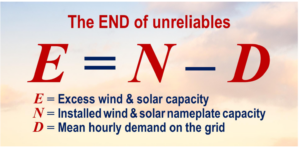Between 2019 and 2022, industries charged with generating U.S. electricity reduced their CO2 emissions by 85.3 million tons (4.7%), dropping them from 1830 to 1745 million tons (EPA eGRID Data Explorer).
Was this reduction attributable to the large-scale installation of solar panels and wind turbines?
Holding geothermal, biomass, hydro, and nuclear generation constant, there are three ways to reduce grid CO2 emissions:
- by generating less power, as France, Germany, the United Kingdom, and Japan have done;
- by replacing coal generation with natural gas or, in theory, and
- by increasing renewables while proportionally reducing fossil fuel-based generation.
The first method does not apply to the US because, during this period, the nation increased electricity consumption by 100 TWh (0.6% per year).
The second method does apply, as coal-fired generation emits about 2.5 times more CO2 than natural gas per MWh, and while coal-fired generation declined by almost 20%, gas-fired generation increased by more than 6%.
The third method – adding wind and solar power to the grid – should be regarded with suspicion. It is not necessarily true that replacing 1 MWh of renewable generation by 1 MWh of fossil fuel-based generation will reduce CO2 emissions from the grid. Depending on the technology and fuels used for backup, emissions may even increase significantly, which is the exact opposite of what was intended. Promoters of wind and solar power usually attribute any reduction in grid CO2 emissions solely to windmills and solar panels, which emit no CO2 at the point of use. However, wind and solar power require thermal generation backup at all times, so there will still be electrical power when the wind drops or the sun sets.
However, apart from being costly and inefficient, thermal sources that are kept running at continuous spinning reserve so they can ramp up when needed will emit more CO2 than when operating normally. It is, thus, necessary to account for the emissions from backup generation, whereupon wind and solar power cease to be zero-emission power sources.
Table 1 shows US CO2 emissions reduction attributable to wind and solar generation on the idealized assumption that only natural gas generation (the most efficient source) is used as a backup. Emissions abatement is CO2 emissions with the current renewable generation fraction (table 3 below), less emissions without renewables (shown here in tons as well as in percentages of US grid emissions, US emissions from all sources, and global emissions from all sources). US emissions are based on data provided by the EPA.
Global emissions are from the Statistical Review of World Energy (Energy Institute 2023).
It turns out, however, that in the US, not only natural gas in combined-cycle plants but also simple-cycle gas turbines, as well as oil and even coal, have been used to back up the grid. Therefore, emissions are much less than that produced by combined-cycle gas backup alone since CO2-output emission rates for the other forms of thermal backup are significantly higher than those of natural gas in combined-cycle plants. Table 2 shows the actual outcome:
It is remarkable that hundreds of billions of dollars in expenditure on wind and solar power over a 20-year period have cut U.S. CO2 emissions by only 0.3% and global emissions by 0%.
What is worse is that for the period from 2019-2022, for every 1 TWh of coal-generation capacity dismantled in the US, China and India have added 5.6 TWh of coal-fired generation.
Furthermore, there is a limit above which any additional wind and solar power will be lost, thereby ceasing to reduce CO2 emissions, unless absurdly expensive lithium-ion batteries or green hydrogen absorb the surplus generation. That limit is reached when the fraction of total grid output generated by wind and solar power exceeds the annual weighted-average- capacity factor, that is when the installed nameplate capacity of unreliables matches the annual mean hourly demand on the grid.
Table 3 shows two different renewable-generation fractions. The first, the ratio of annual wind and solar generation to total US annual generation from all sources, is usually used to show the degree of progress towards net zero. Thus, the US should still have plenty of room to continue plaguing its territory with unreliables because it seems to be far from its green generation limit of, erroneously imagined, 100%.
For technical reasons, coal, geothermal, biomass, run-of-the-river hydropower, and nuclear power are largely used for baseload generation. Therefore, to establish how far a national grid is from its limit on wind and solar generation, the correct generation fraction is the ratio of annual wind and solar generation to total thermal generation suitable for backup, that is, oil and natural gas.
Although highly expensive reservoir-hydropower stations are well-suited for this purpose, they were designed to satisfy demand rather than backup unreliables. Besides, from 2019 to 2022, U.S. hydropower generation dropped by 12%.
In any case, if used as such, from where would the missing generation come when backing up solar panels rather than supplying for demand? Oh yes, from oil and gas generation. Thus, in Table 3, one must consider renewable generation as a percentage of oil and gas generation (row 2) rather than that of total generation (row 1). On that basis, the US almost reached the limit on generation by unreliables in 2022. It is very likely that that limit was exceeded in 2023. The US, like Europe, may as well have joined the grid-killing unreliables’ club.
What happens next?
While in 2019, there was still some slack for increasing wind and solar generation, from 2023, there will no longer be any. Hence, on the US grid, there will be no further reductions in CO2 emissions. The cost of electricity will continue to rise, aggravated by the introduction of costly and damaging European-style market interferences, such as cancellation, curtailment, or constraint orders that have the effect of subsidizing wind and solar generators for non-existent additional power at the expense of customers.
The worst is yet to come, however. If reliable and affordable thermal generation, essential for backup, continues to be foolishly dismantled without regard to the renewable generation limit, from here on, we face the likelihood of nationwide, Texas-like blackouts.
As a direct result of the enormous cost of net-zero policies in the US, including the dismantling of sound, coal-fired power stations and the installation of windmills and solar panels, coupled with the large on-costs to the rest of the grid, domestic electricity prices in the US are already double those in China and India, two-and-a-half times those in Russia, and triple those in Pakistan.
Meanwhile, China permitted 43 new, 2-GW coal-fired power stations in 2023 alone to add to its existing fleet, which is now approaching 1,200 power stations. Russia has almost no wind or solar generation. India is increasing its coal-fired fleet by 60% and Pakistan by 300%.
Time for a rethink.




